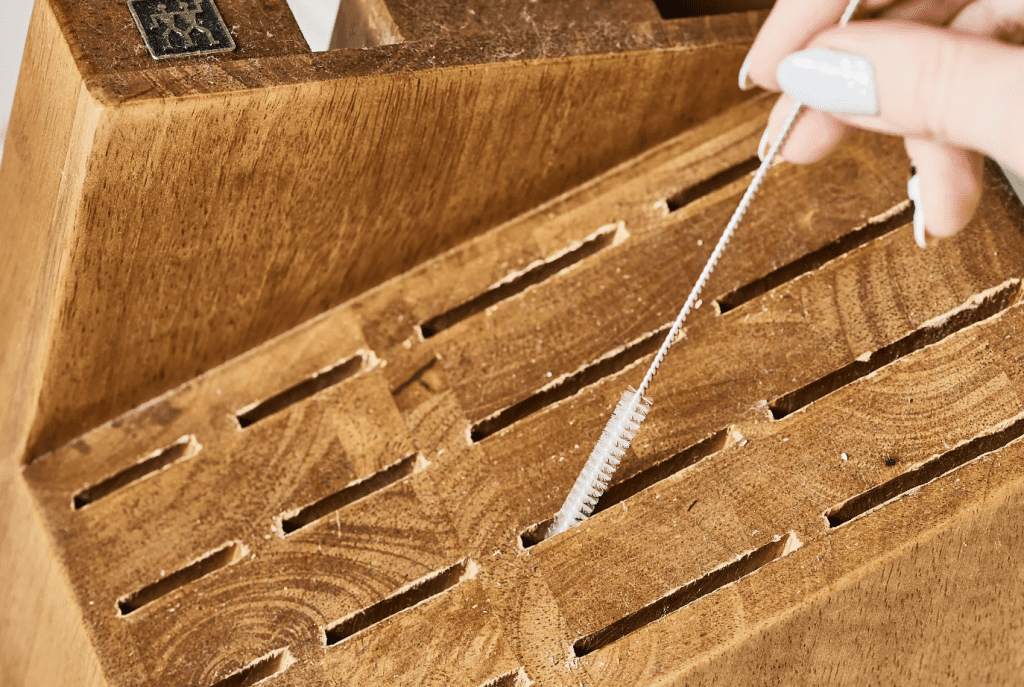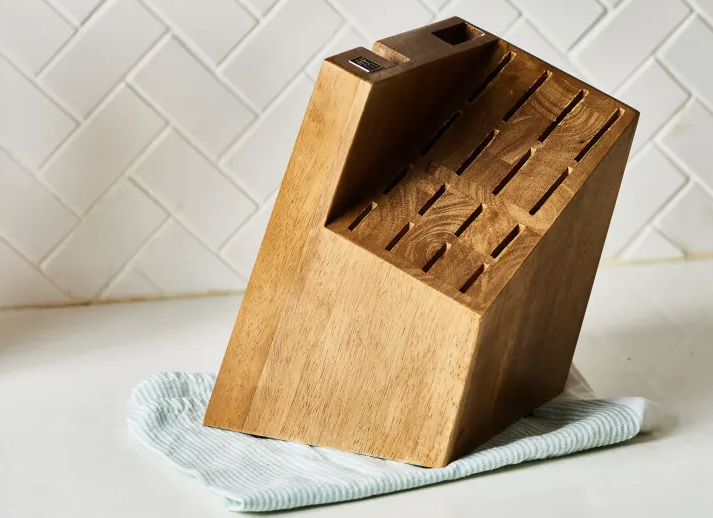How to Clean a Knife Block: Effective Tips and Techniques
Learning how to clean a knife block is an essential skill for maintaining the hygiene and longevity of your kitchen tools. Knife blocks, especially wooden ones, can harbor bacteria and food residue if not cleaned properly. In this comprehensive guide, we will explore various methods and techniques to keep your knife block in pristine condition.
We will discuss the importance of cleaning a knife block regularly to prevent bacterial growth and ensure food safety during preparation. Our step-by-step instructions on removing debris from knife slots, washing exterior surfaces, drying wooden blocks effectively, as well as hand-washing individual knives will help you maintain cleanliness in your kitchen.
In addition to these practical tips on how to clean a knife block, we also cover essential kitchen safety measures for proper storage and handling of knives. Furthermore, our recommendations on reconditioning wooden blocks using mineral oil aim at prolonging their lifespan while offering alternative storage options such as magnetic stands or in-drawer organizers.
Cleaning the Interior of a Knife Block
Don’t let bacteria build up in your knife block regularly; use a firm bottle brush with hot soapy water to scrub each slot, rinse under running tap water, and dry completely with a soft cloth.

Removing Knives from the Block Before Cleaning
Prevent accidental injuries and ensure proper access for cleaning by removing all knives from their respective slots before cleaning your wooden knife block.
Shaking Out Loose Crumbs or Debris From The Slots
Turn your knife block upside down and give it a few gentle taps to remove loose crumbs or use a small brush like an old toothbrush or pipe cleaner to dislodge stubborn particles.
- Bottle Brush: A firm bottle brush is ideal for removing accumulated grime from narrow knife slots.
- Pipe Cleaner: Pipe cleaners work well in getting rid of hard-to-reach dirt trapped within tiny crevices present throughout various sections of most standard-sized blocks.
- Toothbrush: An old toothbrush can be repurposed as an effective tool when dealing specifically with smaller-sized blocks designed for paring or steak knives.
Rinse your knife block under running tap water to ensure all soap suds are washed away completely, and dry it with a soft cloth to prevent residual moisture from causing damage.
Properly clean your knife block to maintain hygiene levels and prevent potential damage caused by residual moisture left behind during cleaning processes.
How to Clean Your Knife Block Properly
Eliminate potential bacterial growth on your knife block’s surface by washing it with hot soapy water and rinsing it well.
Thorough Rinsing is Key
Rinse your knife block under running tap water until no more suds appear to prevent bacteria buildup.
Dry Excess Moisture Immediately
Pat down the exterior surface with a clean dish towel or paper towels to absorb any remaining moisture around each slot opening.
- Tip: Use an improvised tool made from a paper clip and cotton swabs to reach deep into narrow knife slots.
- Note: Avoid using abrasive materials like steel wool or scouring pads to prevent scratching and damaging the wood’s surface.
Remember to clean your knife block regularly to prevent food residue from accumulating within the slots.
For more tips on proper knife care techniques and alternative storage solutions, check out our blog post series “Stirring With Knives.”
Proper Air-Drying Techniques for Wooden Knife Blocks
Ensure your wooden knife block is dry by propping it up in an area with good airflow and low humidity, and wait at least 12 hours for it to completely dry.
Avoid heat sources and check for visible dampness and food residue odors before reinserting knives.
- Note: Wait until the entire block is dry before storing knives to prevent mold growth.
- Don’t use your knife block immediately after cleaning to avoid introducing bacteria.

Maintaining Cleanliness Among Individual Knives
Hand-wash knives with warm soapy water and dry them completely before storing them back in their designated slots.
High-carbon steel blades require extra care to prevent rusting, so wipe them down with a soft cloth and avoid scrubbing with brushes.
- Cut away from yourself, avoid touching edges directly, and store knives securely to ensure kitchen safety.
Maintaining Cleanliness Among Individual Knives
After cleaning your wooden knife block, it’s crucial to keep your individual knives clean by hand-washing them with warm soapy water and never putting them in the dishwasher.
Hand-Washing Techniques for Different Types of Knives
Clean chef’s knives with a soft sponge, serrated knives with a gentle brush, and paring knives with a soft sponge, all while avoiding direct contact with sharp edges.
Kitchen Safety Tips When Handling Sharp Objects
Wash your hands before and after handling knives, hold the knife by its handle, avoid using abrasive materials, and store sharp objects securely.
Heeding these safety guidelines will not only keep you and your knives safe, but also guarantee their cleanliness and readiness for use.
Reconditioning Your Knife Block with Mineral Oil
Revive your wooden knife block with mineral oil to extend its lifespan and keep it looking new.
Choosing the Right Mineral Oil
Select a food-safe mineral oil to avoid rancid odors and ensure safety for food contact surfaces.
Frequency and Application Techniques
- Clean the Surface: Thoroughly clean and dry your knife block before applying mineral oil.
- Pour a Small Amount: Use a soft cloth or applicator bottle to apply a small amount of mineral oil.
- Rub Gently: Rub the oiled cloth along all exposed wood grain areas until evenly coated.
- Allow to Absorb: Let the mineral oil soak for 20-30 minutes before wiping away any excess.
- Maintain Regularly: Reapply mineral oil every few months to keep your knife block in top condition.
Follow these steps to keep your knife block looking and functioning like new for years to come.
Alternative Storage Options for Knives
Are you in search of an alternative storage solution for your knives? Consider these alternative options:
Magnetic Knife Strips
Magnetic knife strips are a space-saving and hygienic option for displaying your knives.
- Easier access: Quickly grab the right knife when you need it.
- Aesthetically pleasing: Add a modern touch to your kitchen decor.
- Versatility: Use the strips for storing other metal utensils like scissors and spatulas.
In-drawer Knife Organizers
If you prefer to keep your knives out of sight, an in-drawer knife organizer is a great solution.
- Space-saving: Free up valuable counter space by keeping your knives tucked away neatly inside a drawer.
- Safety: Reduce the risk of accidentally cutting yourself by using an organizer with designated slots for each blade.
- Customizable options: Choose from various designs that can fit different knife sizes and shapes.
Remember to properly clean your knives after each use with warm soapy water and a small brush or pipe cleaner to remove any food residue. Dry them completely with a soft cloth before storing them in their designated spaces within the knife block or alternative storage option.
How to Clean a Knife Block
If you’re a home cook who uses knives regularly, you know how important it is to keep them clean and sharp. But what about your knife block? It’s easy to forget that this kitchen tool needs regular cleaning too. Here’s how to properly clean your knife block:
What is the best way to clean a knife block?
The most effective method for cleaning a knife block involves removing debris from the slots, washing exterior surfaces with warm soapy water, and allowing it to air-dry completely. Use a small brush or pipe cleaner to effectively clean inside each slot. Regularly recondition your wooden knife block using mineral oil.
How do you clean a knife block with bristles?
To clean a bristle-lined knife block, first remove any loose debris by turning it upside down and shaking gently. Then use compressed air or a vacuum attachment to remove remaining particles between the bristles. Wipe down exterior surfaces with warm soapy water and allow ample time for air-drying before storing knives again.
How do you restore a knife block?
To restore an old or worn-out wooden knife block, begin by thoroughly cleaning it as described above. Once dry, lightly sand its surface using fine-grit sandpaper until smooth. Apply food-safe mineral oil evenly on all surfaces of the wood and let it soak in overnight before wiping off excess oil.
How sanitary are knife blocks?
Knife blocks can be sanitary if properly maintained through regular cleaning and drying routines that prevent bacterial growth within slots and on external surfaces. Ensure proper hand-washing of individual knives prior to storage in order to maintain optimal hygiene levels within your kitchen environment.
Remember to always dry your knife block completely before storing knives to prevent moisture buildup and potential bacterial growth. Use a soft cloth to wipe down the exterior surfaces and allow it to air-dry completely. By following these simple steps, you can ensure that your knife block stays clean and sanitary for years to come.
Conclusion
Don’t neglect your knife block – keeping it clean is crucial for knife safety and longevity.
- Remove debris from the slots.
- Wash the exterior surfaces.
- Dry properly.
- Hand-wash individual knives.
- Follow kitchen safety tips for handling knives.
- Recondition wooden blocks with mineral oil.
- Consider alternative storage options like magnetic stands or in-drawer organizers.
Remember, cleanliness is key when it comes to food preparation – follow these steps to ensure your knives are always ready for use.
